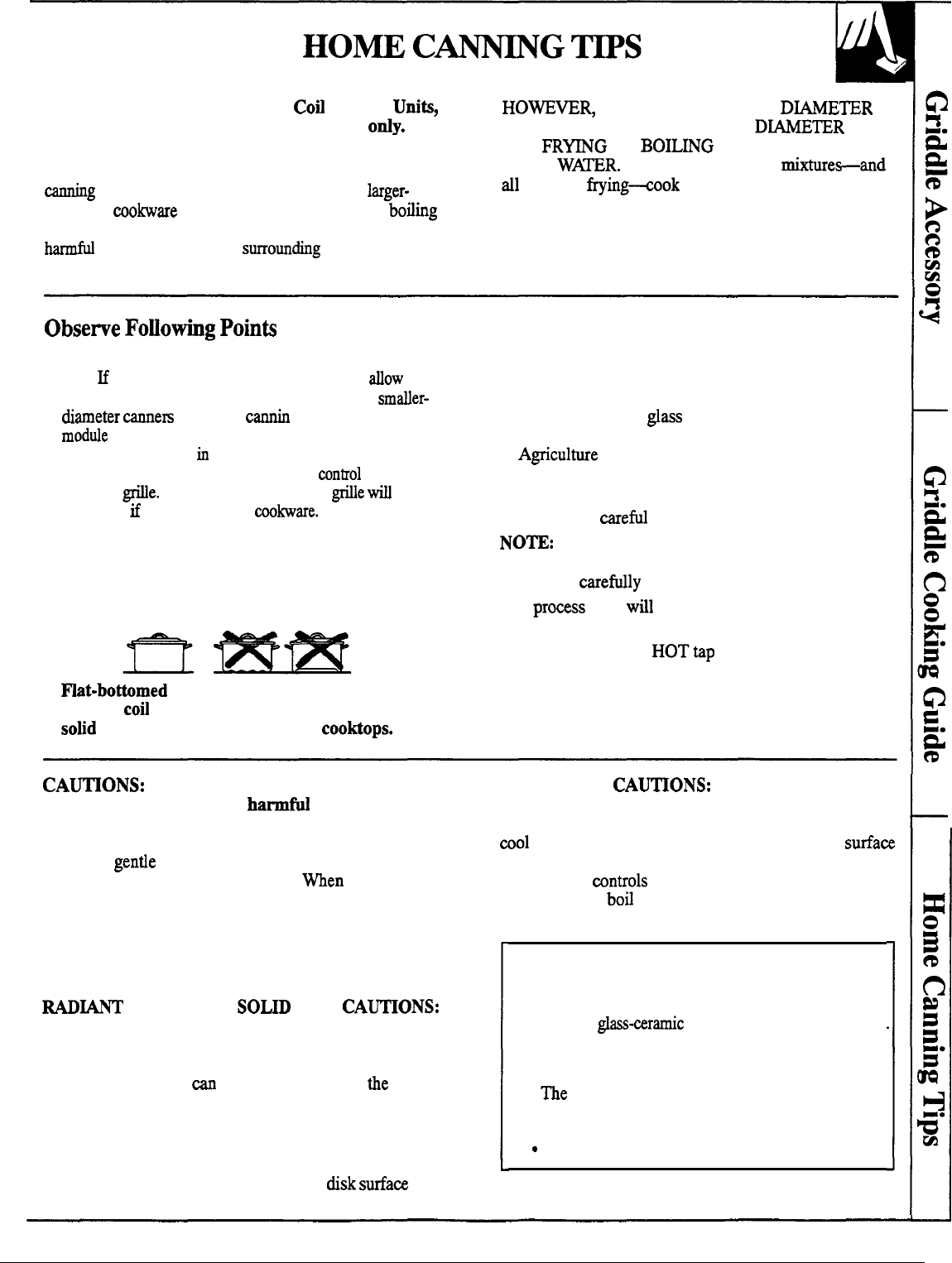
Canning should be done on the
Cofl
Surface Unik,
HOWE~R,
DO NOT USE LARGE
DNETER
the Solid Disk Units or the Radiant Units
ody.
CANNERS OR OTHER LARGE
DWETER
POTS
Pots that extend beyond 1 inch of the surface unit are not
FOR
FR~G
OR
BOIL~G
FOODS OTHER
recommended for most surface cooking. However, when
THAN
W~R.
Most syrup or sauce rnixture%and
-g
with a water-bath or pressure canner,
larger-
dl
types of
frying~ook
at temperatures much higher
diameter
mokware
maybe used This is because
boding
than boiling water. Such temperatures could
water temperatures (even under pressure) are not
eventually harm cooktop surfaces surrounding the
~
to cooktop surfaces
smounding
the surface unit.
module surface units.
Obse~e
Fo~otig
Pointi
in Canning
1.
Be sure the canner fits over the center of the surface
unit.
H
your cooktop or its location does not
Wow
the
canner to be centered on the surface unit, use
smMer-
diarneter
cannem
for good
cannin
g results or try putting
modde
on opposite side of cooktop (on some models)
so the larger unit is
in
front. Be sure the canner or other
large diameter pans do not touch the
mntrol
knobs or
the vent
@e.
The knobs and the vent
@e
W
be
damaged
M
touched by hot
mkware.
2. flat-bottomed canners must be used. Do not use
canners with flanged or rippled bottoms (often
found in enamelware) because they don’t make
enough contact with the solid disk surface unit
and take a long time to boil water.
~at-bottomed canners are recommended for
electric
coil
surface units. They are
required
for
so~d
disk surface units and glass
cooktops.
3. When canning, use recipes and procedures from
reputable sources. Reliable recipes and procedures
are available from the manufacturer of your canner;
manufacturers of
@ass
jars for canning, such as
Ball and Kerr; and the United States Department of
A@culture
Extension Service.
4. Remember that canning is a process that generates
large amounts of steam. To avoid burns from steam
or heat, be
careti
when canning.
NO~:
If your house has low voltage, canning may
take longer than expected, even though directions
have been
caretily
followed.
The
prouss
time
wfll
be shortened by:
(1)
using a pressure canner, and
(2) starting with
HOTtap
water for fastest
heating of large quantities of water.
CA~ONS:
Safe canning requires that
harmti
microorganisms
are destroyed and that the jars are sealed
completely. When canning foods in a water-bath
canner, a
gende
but steady boil must be maintained
continuously for the required time.
men
canning
foods in a pressure canner, the pressure must be
maintained continuously for the required time.
After you have adjusted the controls, it is very
important to make sure the prescribed boil or
pressure levels are maintained for the required time.
RAD~
GLASS AND
SOHD
DISK
CA~ONS:
The glass and solid disk surface units have
temperature limiters that help prevent them from
getting too hot. If the bottom of your canner is not
flat, the surface unit
a
overheat, triggering
the
temperature limiters to turn the unit off for a time. This
will stop the boil or reduce the pressure in the canner.
Since you must make sure to process the canning jars
for the prescribed time, with no interruption in processing
time, you cannot can on glass or solid
tisk
surfam
units if the bottom of your canner is not flat enough.
SOLID DISK
CA~ONS:
If a solid disk surface unit is used for canning,
please note that solid disk surface units heat up and
mol down more slowly than other electric coil
surfaw
units. Because of this difference, after you have
adjusted the
@ntrols
it is very important to make sure
the prescribed
bofl
or pressure levels are maintained
for the required time.
What is a Temperature Limiter?
Every solid disk and radiant surface unit has a
Temperature Limiter. The Temperature Limiter
protects the
~ass~rarnic
surface from getting too hot
The Temperature Limiter may turn off the
surface units if:
●
The
pan boils dry.
●
The pan bottom is not flat.
●
The pan is off center.
“
There is no pan on the unit.
25


















